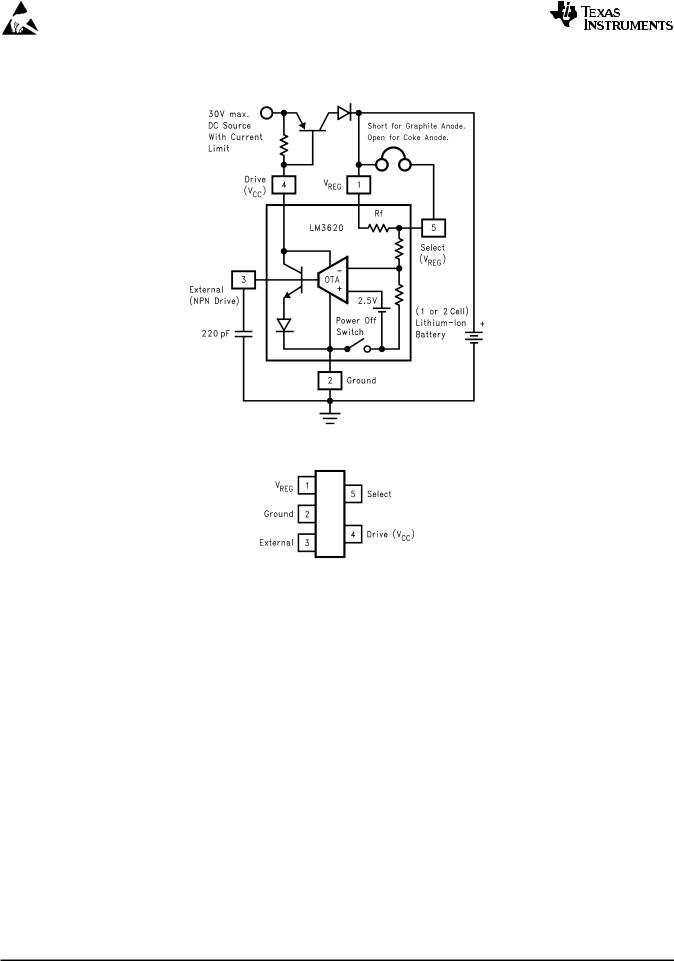Texas Instruments LM3620 Schematics

OBSOLETE
LM3620
www.ti.com |
SNVS025D –JUNE 1999 –REVISED APRIL 2013 |
LM3620 Lithium-Ion Battery Charger Controller
Check for Samples: LM3620
FEATURES
•Voltage Options for Charging 1 or 2 Cell Stacks
•Adjustable Output Voltage for Coke or Graphite Anodes
•Precision End-of-Charge Voltage Control
•Wide Input Voltage Range (4V to 30V)
•Low Off State Current (<10nA)
•Drive Provided for External Power Stage
•Tiny SOT-23 Package
DESCRIPTION
The LM3620 series of controllers are monolithic integrated circuits designed to control the charging and end-of-charge control for lithium-ion rechargeable batteries. The LM3620 is available in two versions for one or two cell charger applications. Each version provides the option of selecting the appropriate termination voltage for either coke or graphite anode lithium cells.
The LM3620 can operate from a wide range of DC input sources (4V to 30V). With no charger supply connected, the controller draws a quiescent current of only 10nA to minimize discharging of a connected battery pack.
The LM3620 consists of an operational transconductance amplifier, a bandgap voltage reference, a NPN driver transistor and precision voltage setting resistors. The output of the amplifier is made available to drive an external power transistor if higher drive currents are required.
With a trimmed output voltage regulation of ±1.2% initial accuracy, the LM3620 provides a simple, precise solution for end-of-charge control of lithiumion rechargeable cells.
The LM3620 is packaged in a miniature 5-lead SOT23 surface mount package for very compact designs.
Please be aware that an important notice concerning availability, standard warranty, and use in critical applications of
Texas Instruments semiconductor products and disclaimers thereto appears at the end of this data sheet.
All trademarks are the property of their respective owners.
PRODUCTION DATA information is current as of publication date. |
Copyright © 1999–2013, Texas Instruments Incorporated |
Products conform to specifications per the terms of the Texas |
|
Instruments standard warranty. Production processing does not |
|
necessarily include testing of all parameters. |
|

OBSOLETE
LM3620
SNVS025D –JUNE 1999 –REVISED APRIL 2013 |
www.ti.com |
Typical Application
Connection Diagram
The small physical size of the SOT23-5 Package does not allow for the full part number marking. Devices will be marked with the designation shown in the column Package Marking.
Figure 1. 5-Lead SOT23-5 Surface Mount Package
See Package MF05A
These devices have limited built-in ESD protection. The leads should be shorted together or the device placed in conductive foam during storage or handling to prevent electrostatic damage to the MOS gates.
2 |
Submit Documentation Feedback |
Copyright © 1999–2013, Texas Instruments Incorporated |
Product Folder Links: LM3620

|
|
OBSOLETE |
|
|
|
|
|
|
LM3620 |
www.ti.com |
|
|
SNVS025D –JUNE 1999 –REVISED APRIL 2013 |
|
ABSOLUTE MAXIMUM RATINGS(1) (2) |
|
|
||
Input Voltage (VDRIVE) |
|
|
|
35V |
VEXT |
|
|
|
1.5V |
Junction Temperature |
|
|
|
150°C |
|
|
|
|
|
Storage Temperature |
|
|
|
−65 to +150°C |
Lead Temp. Soldering |
|
Vapor Phase (60 sec.) |
|
215°C |
|
|
|
|
|
|
|
Infrared (15 sec.) |
|
220°C |
|
|
|
|
|
Power Dissipation (T |
= 25°C)(3) |
|
300mW |
|
A |
|
|
|
|
ESD Susceptibility(4) |
|
|
|
2000V |
(1)Absolute Maximum Ratings indicate limits beyond which damage to the device may occur. Operating Ratings indicate conditions for which the device is intended to be functional, but do not ensure specific performance limits. For ensured specifications and test conditions, see the Electrical Characteristics.
(2)If Military/Aerospace specified devices are required, please contact the TI Sales Office/ Distributors for availability and specifications.
(3)The maximum power dissipation must be derated at elevated temperatures and is limited by TJMAX (maximum junction temperature), θJ-A (junction-to-ambient thermal resistance) and TA (ambient temperature). The maximum power dissipation at any temperature is: PDissMAX = (TJMAX − TA)/θJ-A up to the value listed in the Absolute Maximum Ratings.
(4)Rating is for the human body model, a 100 pF capacitor discharged through a 1.5kΩ resistor into each pin.
OPERATING RATINGS(1)
Ambient Temp. Range |
0°C to 70°C |
|
|
Junction Temp. Range |
0°C to 125°C |
|
|
Thermal Resistance (Junction to Ambient, θJ-A) |
280°C/W |
Input Voltage (VDRIVE) |
4V to 30V |
(1)Absolute Maximum Ratings indicate limits beyond which damage to the device may occur. Operating Ratings indicate conditions for which the device is intended to be functional, but do not ensure specific performance limits. For ensured specifications and test conditions, see the Electrical Characteristics.
ELECTRICAL CHARACTERISTICS LM3620-4
VDRIVE = 5V, IDRIVE = 2mA. Limits with boldface type apply over the full operating ambient temperature range, 0°C to +70°C, limits with standard typeface apply for TA = 25°C.
Symbol |
Parameter |
|
|
|
Conditions |
Typical |
Limit |
Units |
|
|
|
|
|
|
|
||||
VREG |
Regulated Output Voltage (pin 1 to |
Pin 5 shorted to pin 1 (graphite anode) |
4.1 |
4.051/4.018 |
V(min) |
||||
|
ground) |
|
|
|
|
|
|
4.149/4.182 |
V(max) |
|
|
|
|
|
|
|
|
||
|
|
Pin 5 open (coke anode) |
4.2 |
4.150/4.116 |
V(min) |
||||
|
|
|
|
|
|
|
|
4.250/4.284 |
V(max) |
|
Regulated Output Voltage |
Either Pin 5 setting |
|
|
±1.2/± 2.0 |
% |
|||
|
Tolerance |
|
|
|
|
|
|
|
|
|
|
|
|
|
|
||||
VREG/VDRIVE |
Supply Sensitivity |
VREG for 5V ≤ VDRIVE ≤ 30V |
100 |
|
µV/V(max) |
||||
I |
Quiescent Current |
V |
= 4.5V, V |
EXT |
= 1.0V(1) |
400 |
750 |
µA(max) |
|
Q |
|
REG |
|
|
|
|
|
|
|
I |
Off State Current |
V |
|
open circuited(2) |
10 |
200 |
nA(max) |
||
OFF |
|
DRIVE |
|
|
|
|
|
|
|
IDRIVE |
Drive Pin Sink Current |
VDRIVE = 5.0V |
|
|
20 |
15 |
mA(min) |
||
Gm(DRIVE) |
Drive Pin Transconductance |
IDRIVE/ VREG |
|
|
3 |
|
A/V |
||
|
|
2mA ≤ IDRIVE ≤15mA |
|
|
|
||||
I |
External Pin Source Current |
V |
= 1V(3) |
|
|
3 |
2.5 |
mA(min) |
|
EXT |
|
EXT |
|
|
|
|
|
|
|
(1)Quiescent current is all current flowing to ground when the voltage at the VREG pin is forced to be above the nominal regulating voltage (VREG).
(2)Off current is all of the current flowing to ground including all leakage current that would be drawn from the battery connected to the VREG terminal.
(3)When the External pin is being used as the driving source, it is recommended to keep the operating point of VEXT ≤ 1V. If greater than 1V, the internal circuitry would bias IDRIVE to conduct up to the current limit level continuously causing unnecessary power dissipation in the device.
Copyright © 1999–2013, Texas Instruments Incorporated |
Submit Documentation Feedback |
3 |
Product Folder Links: LM3620
